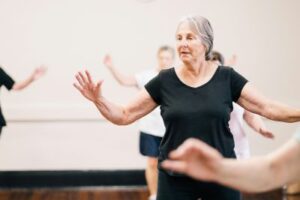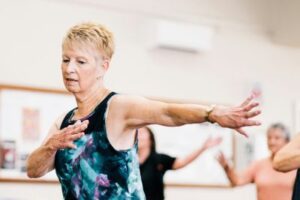How Gentle Exercise Can Improve Mobility and Mood for Seniors
Aging doesn’t have to mean slowing down to a standstill. In fact, one of the best ways to stay active, mobile, and emotionally well as we grow older is through gentle exercise. Designed specifically with comfort, safety, and effectiveness in mind, gentle exercise improves mobility and mood for seniors—without putting too much strain on aging joints.
In this article, we’ll explore how movement—when done right—can offer incredible mental and physical benefits. From easing arthritis pain to lifting spirits, gentle workouts can be a game-changer for older adults.
Let’s dive in and discover how you or your loved ones can thrive through the power of motion.
What Is Gentle Exercise?
Key Examples of Gentle Exercises
Gentle exercise refers to physical activity that is low-impact, easy on the joints, and adaptable to different mobility levels. Unlike high-intensity workouts, these movements are less about sweating and more about sustained, smooth, and controlled motion.
Common types of gentle exercise include:
-
Walking at a leisurely pace
-
Seated chair yoga
-
Tai Chi or Qigong
-
Stretching or light resistance band work
How It Differs from Moderate or Intense Workouts
Whereas moderate or intense exercise might elevate your heart rate dramatically or include weightlifting and cardio sprints, gentle exercise focuses on longevity, not speed. It aims to:
-
Improve mobility
-
Maintain muscle tone
-
Support mental health
-
Reduce pain or discomfort
That’s why it’s perfect for seniors looking to maintain independence and emotional well-being.

The Science Behind Movement and Mental Well-being
Brain Chemistry and Physical Activity
Exercise boosts the release of endorphins and serotonin, neurotransmitters that help regulate mood and reduce stress. These “feel-good” chemicals are especially important for seniors, who may face increased risks of depression or anxiety due to isolation or health issues.
In fact, research from Harvard Medical School shows that regular physical activity is as effective as antidepressants in some cases of mild to moderate depression.
How Movement Affects Seniors Differently
For older adults, movement does more than just lift spirits—it can:
-
Slow cognitive decline
-
Improve memory
-
Sharpen reflexes
-
Enhance emotional resilience
Exercise becomes a form of preventative medicine—improving brain health while easing physical pain.
op 7 Benefits of Gentle Exercise for Seniors
1. Improved Joint Health
Gentle exercise helps lubricate joints, reducing stiffness from conditions like arthritis. Movement stimulates the production of synovial fluid, which acts as the body’s natural joint oil.
2. Enhanced Balance and Coordination
Exercises like Tai Chi focus on slow, deliberate movements. These help seniors develop better body awareness, reducing the risk of falls—a leading cause of injury in older adults.
3. Better Mood and Mental Health
Whether it’s through walking or water aerobics, gentle exercise releases feel-good hormones. This can reduce feelings of loneliness, anxiety, or depression—especially when done in groups.
4. Stronger Muscles Without Strain
Even low-impact movement helps preserve muscle mass, which is vital for daily activities like climbing stairs, carrying groceries, or rising from a chair.
5. Better Sleep Patterns
Exercise helps regulate circadian rhythms, making it easier to fall asleep and stay asleep—something many seniors struggle with.
6. Increased Social Interaction
Group classes, walking clubs, or dance sessions provide social stimulation, which can boost self-esteem and prevent cognitive decline.
7. Boosted Immune Function
Regular movement helps stimulate lymphatic flow and circulation, which in turn supports a healthy immune system.

Best Gentle Exercises for Seniors
Chair Yoga and Seated Stretches
Great for those with limited mobility or balance issues. Focuses on breathing, flexibility, and posture.
Water Aerobics and Swimming
Water reduces the body’s weight, making movement easier on the joints. Ideal for seniors with arthritis or chronic pain.
Tai Chi and Qigong
Ancient Chinese practices that combine fluid motion with deep breathing. They’re known to improve both mental clarity and physical strength.
Walking and Nordic Walking
Simple, effective, and free. Adding poles (as in Nordic walking) engages upper-body muscles and improves posture and gait.
Creating a Safe Exercise Routine at Any Age
Consulting with Healthcare Providers
Always consult a doctor before starting any new fitness program, especially if you have existing conditions.
Using the Talk Test for Intensity
If you can talk but not sing during exercise, you’re likely in a safe zone. This test helps prevent overexertion.
Importance of Warm-Up and Cool-Down
Prepare the body and protect the heart. A gentle 5-10 minute stretch before and after is key for injury prevention.
Common Myths About Seniors and Exercise
“I’m Too Old to Start”
Age is just a number! Even those in their 80s and 90s have seen dramatic improvements in mobility and mood after beginning gentle exercise routines.
“Exercise Is Dangerous for Seniors”
When done correctly, it’s not dangerous—it’s life-enhancing. Gentle exercises are specifically designed to avoid strain and support safety.

FAQs About Gentle Exercise for Seniors
1. How often should seniors do gentle exercise?
Ideally, at least 30 minutes a day, 5 days a week, or as advised by a doctor.
2. Can gentle exercise help with chronic pain?
Yes, it can reduce stiffness and improve flexibility, especially in conditions like arthritis.
3. Is it safe for seniors with heart conditions?
Often, yes—but only with a doctor’s clearance and a customized plan.
4. What equipment is needed?
Minimal. Comfortable clothes, supportive shoes, or a chair for seated exercises.
5. Can I do these exercises at home?
Absolutely. Many seniors follow online videos or printed routines.
6. Is walking enough as gentle exercise?
Yes—especially if done regularly and combined with some stretching or strength work.
Movement as Medicine for Aging Gracefully
Gentle exercise isn’t just about staying fit—it’s about staying free, joyful, and connected. Whether you’re 60 or 90, incorporating low-impact movement into your daily routine can transform your mobility and mood.